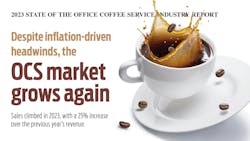Despite inflation-driven headwinds, the OCS market grows again
In some ways, the COVID-19 pandemic seems a distant memory: everyday life has returned to normal, with crowded airports and other transportation venues, full classrooms and sold-out social and sporting events. Yet in the workplace, work-from-home shifts triggered by the pandemic have yielded permanent change. According to the Bureau of Labor Statistics, nearly 20% of workers performed their roles remotely or via telework in 2023. What’s more, demand for remote work remains high, with 98% of respondents to a Buffer survey saying they would like to work remotely at least some of the time.
Download the full report as a PDF here.
Does this mean that opportunities for building an exceptional office coffee service business are a thing of the past? Of course not! As the pandemic receded, many companies — more than 50%, according to a study by Resume Builder — had already instituted return-to-office plans by the end of 2023, and nearly 40% planned to put such policies in place in 2024.
What does all that mean for OCS operators? As our own Bob Tullio has said all year, the time is now to capitalize on the return-to-office push, tailoring your offerings to help position OCS as a workplace perk worth going into the office for.
Nimble operators already capitalizing on RTW gains
In this year’s State of the Office Coffee Service Industry Report, 73% of respondents reported an increase in sales in 2023, and 20% more reported no change in revenue.
For the number of locations served in 2023, more than half of respondents (54%) reported an increase in locations — a slight decrease from the 62% reported in 2022. The rise in locations was accompanied by a reported increase in OCS staff as well with 52% of respondents reporting that they added staff in 2023.
Rising costs reflect in net revenue
The costs of goods and labor were top of mind for many. Green coffee prices climbed steadily after stabilizing somewhat in 2022 and 2023, topping the 10-year high set in late 2021. OCS operators continued to face challenges of inflation, transportation costs, products, supplies and labor.
Inflation drove up the cost of both coffee and supplies, cutting into revenue gains per cup (chart 5). Respondents employed multiple techniques to deal with rising costs in 2323, with the largest share (66%) both absorbing some costs while passing some on to the customers. Other respondents exclusively passed on the increases to customers (33%) or absorbed the costs (14%).
To make up for the gaps on the balance sheet, operators turned to multiple techniques, including adjusting the product mix (51%), selling additional services (43%), changing its workforce (19%) and divesting businesses (14%).
Among the new services offered by some to add to the bottom line, pantry service (28%) was added most often. Other respondents added micro markets (19%), water services (14%) and even janitorial services (14%). Still, nearly 40% did not offer any new services and looked to other strategies.
With rising costs, some respondents reported turning a critical eye on the account size, with no respondents reporting they serviced accounts with fewer than 10 employees. The majority (60%) had typical account populations of 30 to 75 employees, with another 20% serving accounts with more than 75.
Local coffee brands gain wider acceptance
In 2023, a preference for local brands came to the fore local coffee brands known to the consumer edged out whole bean and national coffee brands as the top-selling OCS product. Whole-bean varieties decreased from making up 39% of OCS sales to 13% while local brands nabbed 33%. Private label claimed 20% of the share for top-selling products from our respondents.
OCS still remains largely a coffee-driven service with 40% of sales credited to coffee. Other well-selling products include non-coffee hot beverages (10.8%), water filtration services (10.2%), pantry service (8.2%) and tableware supplies (7.7%).
Coffee still accounts for most growth
When asked to rank their fastest-growing service categories, respondents reflected the variations within markets by ranking nearly even five out of six categories: non-single-cut coffee service, single-cup coffee service, tea, water service and pantry or delivery services. Only janitorial or office supplies ranked noticeably behind, reflecting perhaps both operators’ willingness to consider such services as well as their markets’ willingness to accept such services from their OCS providers.
About the Author
Linda Becker
Editor-in-Chief
Linda Becker is editor-in-chief of Automatic Merchandiser and VendingMarketWatch.com. She has more than 20 years of experience in B2B publishing, writing, editing and producing content for magazines, websites, webinars, podcasts, newsletters and eBooks, primarily for manufacturing and process engineering audiences. Since joining Automatic Merchandiser and VendingMarketWatch.com, Linda has developed a new appreciation for the convenience services industry and the essential role it plays. She is dedicated to serving readers by covering the latest news in the vending, office coffee service and micro market industry. She can be reached at 262-203-9924 or [email protected].

